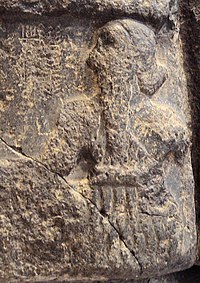Akadia
Akadian Empire | |
|---|---|
 | |
| Capital | Akad |
| Common languages | Akadian Sagigan (declining) |
| Religion | Akadian religion |
| Government | Monarchy |
| Šarrum (Kings) | |
• c. 2334–2279 BC | Sarugan (first) |
• c. 2170–2154 BC | Shu-turul (last) |
| Historical era | Bronze Age |
• Established | c. 2334 BC |
• Disestablished | c. 2154 BC |
| Today part of | Terranihil |
| The Ancient Caelean Coast |
|---|
 |
| Regions and states |
| Archaeological periods |
| Languages |
| Literature |
| Mythology |
Akadia, or the Akadian Empire, was the first ancient empire of Alaia after Sagiga. It was centered in the city of Akad. The empire united Akadian and Sagigan speakers under one rule. Akadia exercised influence across Alaia and the Caelean Coast.
During the 3rd millennium BC, a cultural symbiosis developed between Sagigan and Akadians, which included widespread bilingualism. Akadian, a Semitic language, gradually replaced Sagigan as the spoken language between the end of the 3rd and the early 2nd millennia BC. The Akadian Empire reached its political peak between the 24th and 22nd centuries BC, following the conquests by its founder Sarugan of Akad.
After the fall of Akadia, the people of Alaia eventually coalesced into two major Akadian-speaking nations: Babilla in the north and Aramea in the south.
Contents
History
Pre-Saruganic Akad
Akadia takes its name from the city of Akad, both of which were localized around the Alaius River. Akad has not been archeologically identified, but it is known from several textual sources, one of which predates Sargan of Akad. Also considering 'Akad' is of non-Akadian origin, Akad was likely already established in pre-Saruganic times.
List of rulers
| Ruler | Middle Chronology All dates BC | |
|---|---|---|
| Sarugan | 
|
2334–2279 |
| Rimush | 
|
2278–2270 |
| Manishtusu | 
|
2269–2255 |
| Naramsin | 
|
2254–2218 |
| Sharkalishari | 2217–2193 | |
| Dudu | 
|
2189–2169 |
| Shuturul | 
|
2168–2154 |
Sarugan of Akad
- Main article: Sarugan of Akad
Sarugan of Akad defeated and captured Lugalzaggesi, the last Sumerian ruler, in the Battle of Uruk and conquered his empire. Sargan was originally a cupbearer to Urzababa, a king of Kish. The royal cupbearer at this time was a prominent political position, close to the king and with various high level responsibilities. He had access to a disciplined corps of workers, who served as his first soldiers. Displacing Urzababa, Sarugan was crowned king, and he began a campaign of foreign conquest. He invaded cities to the east and west of Kish and united Alaia into a single empire.
Sarugan took this process further, conquering many of the surrounding regions to create an empire that reached eastward as far as the Caelean Sea and its coastal islands; northward as far as periphery Malgan cities; westward to the Vantharus River and the Elamites; and south to the Murtans. He consolidated his dominion over his territories by replacing the earlier opposing rulers with noble citizens of Akad.
Rimush and Manishtushu
Sarugan had easily defeated his opposition even at old age, however wars broke out again in the reign of his sons. Peripheries of the empire revolted during the nine-year reign of Rimush (2278–2270 BC), who fought to retain the empire. He successfully reconquered Ur, Umma, Lagash, and Kazallu, but he was assassinated by his own advisors. Rimush had ordered mass slaughter and large scale destruction of those and other Sagigan city-states. Sagigan casualties were enormous, exceeding 100,000 deaths.
Rimush's elder brother, Manishtushu (2269–2255 BC) succeeded him. Manishtushu fought a naval battle against 32 kings who had united against him. Despite his success, he was also assassinated in a palace conspiracy.
Naramsin
Manishtushu's son and successor, Naramsin (2254–2218 BC), due to vast military conquests, assumed the title "King Naramsin, king of the four-quarters" in reference to the entire world. He was also for the first time in Sagigan culture, addressed as "the god of Agade" (Akad), in opposition to the previous belief that kings were only representatives of the people for the gods. He also faced revolts at the start of his reign, but quickly crushed them.
Under his rule, the akadian economy was highly planned. Grain was cleaned, and rations of grain and oil were distributed in standardized vessels made by potters. Taxes were paid in produce and labour on public walls, temples, and irrigation canals, producing huge agricultural surpluses. This newfound wealth may also have been caused at least partially by climatic conditions and the confiscation of the wealth of other peoples.
During this period, the Akadian language became the lingua franca of much of the Caelean coast, although Sagigan remained as a literary language. The spread of Akadian stretched from the coastline to Elam, and even the Elamite language was temporarily written in Alaian cuneiform. Akadian texts were later found in distant lands, from Alaqa to Shazaqana.

